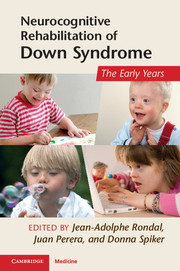Book contents
- Frontmatter
- Contents
- List of contributors
- Preface
- Acknowledgments
- Section 1 Definition, history, methodology, and assessment
- Section 2 Genetics, brain, and animal models
- Section 3 Pharmacological and medical management and treatment
- Section 4 Early development and intervention
- 10 Developmental models as frameworks for early intervention with children with Down syndrome
- 11 Aspects of motor development in Down syndrome
- 12 Memory development and learning
- 13 Prelinguistic and early development, stimulation, and training in children with Down syndrome
- 14 Speech perception, stimulation, and phonological development
- 15 Goal-directedness as a target for early intervention in Down syndrome
- 16 The role of parents of children with Down syndrome and other disabilities in early intervention
- Section 5 Therapeutic perspectives
- Conclusions
- Index
- References
16 - The role of parents of children with Down syndrome and other disabilities in early intervention
Published online by Cambridge University Press: 05 July 2011
- Frontmatter
- Contents
- List of contributors
- Preface
- Acknowledgments
- Section 1 Definition, history, methodology, and assessment
- Section 2 Genetics, brain, and animal models
- Section 3 Pharmacological and medical management and treatment
- Section 4 Early development and intervention
- 10 Developmental models as frameworks for early intervention with children with Down syndrome
- 11 Aspects of motor development in Down syndrome
- 12 Memory development and learning
- 13 Prelinguistic and early development, stimulation, and training in children with Down syndrome
- 14 Speech perception, stimulation, and phonological development
- 15 Goal-directedness as a target for early intervention in Down syndrome
- 16 The role of parents of children with Down syndrome and other disabilities in early intervention
- Section 5 Therapeutic perspectives
- Conclusions
- Index
- References
Summary
Contemporary early intervention has been closely tied to the proposition that interventions that directly involve parents are more effective at promoting children's learning and development than those that do not (White et al., 1992). This proposition was part of the rationale for the design of the federally mandated early intervention program in the United States, which required that every family in this program have an Individualized Family Service Plan (IFSP). While one of the purposes of the IFSP was to ensure that parents have the resources and supports they need to care for their children, an equally important purpose was to help parents become active participants in their children's intervention. The committee report for the 1986 amendments to the Education of the Handicapped Act (Public Law 99–457) stated,
The committee received overwhelming testimony affirming the family as the primary learning environment for children less than six years of age and pointing out the critical need for parents and professionals to function in a collaborative manner.
(From House Report No. 99–860, as cited in Gilkerson et al., 1987, p. 20.)The emphasis on involving parents in children's intervention services stems from ecological theories of child development (Bronfenbrenner, 1992, 1999; Dunst et al., 2000, 2006; Sameroff & Fiese, 2000). These theories postulate that early developmental learning is a continuous process that can be affected by each of the experiences children have in their daily environment.
- Type
- Chapter
- Information
- Neurocognitive Rehabilitation of Down SyndromeEarly Years, pp. 205 - 223Publisher: Cambridge University PressPrint publication year: 2011
References
- 1
- Cited by



